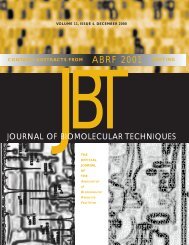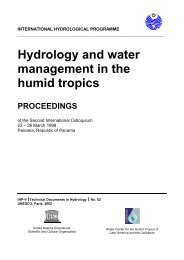Topic Detection and Tracking using idf-Weighted Cosine Coefficient
Topic Detection and Tracking using idf-Weighted Cosine Coefficient
Topic Detection and Tracking using idf-Weighted Cosine Coefficient
You also want an ePaper? Increase the reach of your titles
YUMPU automatically turns print PDFs into web optimized ePapers that Google loves.
2.2. <strong>Detection</strong> Results <strong>and</strong> Conclusions<br />
There is a major shortcoming to this approach which we chose to accept<br />
due to the ease of implementation <strong>and</strong> constraints of time. Two<br />
clusters which one would expect to remain distinct when examining<br />
their content, may become merged through intermediary stories in<br />
an effect called chaining. We found this particularly troublesome<br />
in the TDT detection task since a small variation in threshold often<br />
leads to completely different topic c<strong>and</strong>idate clusters for scoring. As<br />
the threshold increases the best c<strong>and</strong>idate clusters grow until a chain<br />
occurs which brings in so much off-topic material as to make it no<br />
longer the best c<strong>and</strong>idate for the topic. This type of phenomenon<br />
makes incremental progress extremely difficult. We expect groupaverage<br />
clustering or incremental clustering to help us around this<br />
problem.<br />
The simple single-linkage<br />
P(miss)P(fa)Ctrack<br />
clustering algorithm performed moderately<br />
well given its inherent shortcomings. It seems clear to us a<br />
successful clustering algorithm must incorporate a representation for<br />
a cluster itself as group average clustering does, in order to avoid the<br />
problem of chaining <strong>and</strong> its resulting difficulties.<br />
Site Story <strong>Weighted</strong><br />
BBN1 0.0941 0.0021 0.0040<br />
UMass1 0.0913 0.0022 0.0040<br />
Dragon1 0.1638 0.0013 0.0045<br />
IBM1 0.1965 0.0007 0.0046<br />
UPenn1 0.2997 0.0011 0.0070<br />
CMU1 0.3526 0.0004 0.0075<br />
CIDR1 0.3861 0.0018 0.0095<br />
UIowa1<br />
P(miss)P(fa)Ctrack<br />
0.6028 0.0009 0.0129<br />
Table 3: Story weighted detection results by site. (deferal=10,<br />
TDT2 evaluation data set, newswire <strong>and</strong> ASR transcripts)<br />
Site <strong>Topic</strong> <strong>Weighted</strong><br />
IBM1 0.1766 0.0007 0.0042<br />
BBN1 0.1295 0.0021 0.0047<br />
Dragon1 0.1787 0.0013 0.0048<br />
CMU1 0.2644 0.0004 0.0057<br />
UPenn1 0.2617 0.0011 0.0063<br />
UMass1 0.2091 0.0023 0.0064<br />
CIDR1 0.3309 0.0018 0.0084<br />
UIowa1 0.4311 0.0009 0.0095<br />
Table 4: <strong>Topic</strong> weighted detection results by site. (deferal=10,<br />
TDT2 evaluation data set, newswire <strong>and</strong> ASR transcripts)<br />
References<br />
1. G. Salton <strong>and</strong> M.J. McGill, “Introduction to Modern Information<br />
Retrieval,” McGraw Hill Book Co., New York, 1983.<br />
2. G. Doddington, “The <strong>Topic</strong> <strong>Detection</strong><br />
<strong>and</strong> <strong>Tracking</strong> Phase 2 (TDT2) Evaluation Plan,” Available at<br />
http://www.nist.gov/speech/tdt 98.htm, 1998.<br />
3. G. Doddington, “The TDT Pilot Study Corpus Documentation,”<br />
Available at http://www.ldc.upenn.edu/TDT/Pilot<br />
/TDT.Study.Corpus.v1.3.ps, 1997.<br />
4. B. Everitt, “Cluster Analysis,” Halsted Press, New York, 1993.<br />
5. A. Martin, G. Doddington, T. Kamm, M. Ordowski, M. Przybocki,<br />
“The DET Curve in Assessment of <strong>Detection</strong> Task Performance,”<br />
EuroSpeech 1997 Proceedings Volume 4, 1997.















